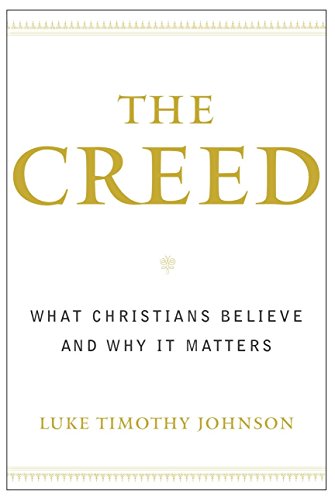This Tuesday we will be discussing Chapter 2 “What the Creed Is and What It Does” of Luke Timothy Johnson’s book, The Creed: What Christians Believe and Why It Matters. This week we are looking at what the purpose of the Creed. Johnson outlines four important roles the Creed plays in the life of the Church.
First, the Creed is a profession of faith, not merely belief. “Belief” refers only to the cognitive dimension of faith, whereas “faith” encompasses the entire human response to God. Belief, however, is the first step into faith and forms the foundation of our common faith. The Creed provides us with this foundation. However, within the liturgy, it also provides us with the faithful response to the Word and Homily.
Second, the Creed is a Rule or Canon of our Faith. It is the lens through which we read the Scriptures and order our experience of God. The creeds arose to combat misreadings of the Scripture. Johnson cites the case of Marcion. Try to understand the Scriptural argument that Marcion taught that the God of Moses was different and inferior to the Father of Jesus. p.47. Many of the early creeds we looked at last week from Ignatius to Tertullian were written with Marcion’s views in mind. If Scripture is our only guide to faith then upon what basis can a person’s own understanding of Scripture be called into question? The Creed, as part of Tradition, provides this basis. In order to read the canon of Scripture correctly, we need to begin with a correct canon of belief.
Third, the Creed defines our faith. It sets forth those boundaries which are essential to Christianity and within which we can have differing opinions. For example, the Creed defines the nature of the Trinity, so that to be a Christian is to confess that the one God of the Shema is three persons and to confess that the second person became Incarnate. On the other hand, although we confess that Christ died for our sins, the nature of the Atonement and the meaning of salvation is left undefined and therefore a matter upon which Christians can disagree. In essentials unity, in non-essentials liberty, and in all things charity.
Finally, the Creed is the Symbol of our Faith. The Eastern Church’s Divine Liturgy uses the term “Symbol” (not the term “Nicene Creed”) as the title for the Creed. In one sense the Creed is a mere symbol, like a cross or a fish, that is a sign of the Christian community. Rotary Club has a four-way test and the Church has the Creed. On a deeper level, however, the Creed is a symbol in a similar fashion as the Eucharist is a symbol. By recitation of the Creed, we participate in the ultimate Reality of which it speaks. The Creed is an invocation of the Deity.
SCHEDULE: Tonight at 6:30 is Epiphany Evensong at Trinity.
Follow-up:
· Last week’s dinner recipe is here.
· Stephen Colbert’s recitation of the Creed is here (at 1:10).
Dinner is at 6. Discussion about 6:30. If you need a book, please let me know. Hope to see you here.
For I do not seek to understand so that I may believe; but I believe so that I may understand. For I believe this also, that ‘unless I believe, I shall not understand.’ (Isa 7:9)
Anslem of Canterbury, Proslogion, § 1

